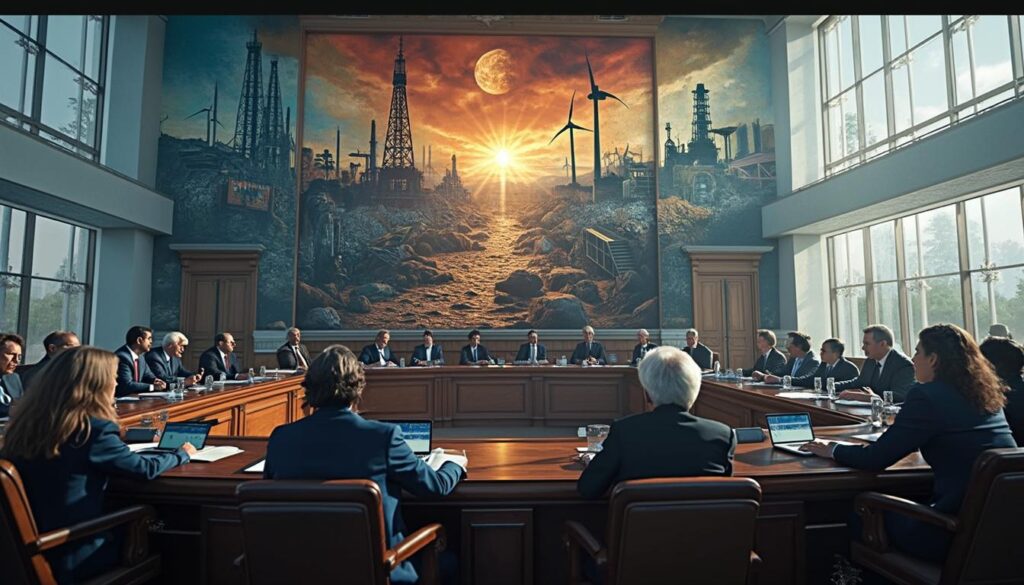A wind of change is sweeping through the renewable energy sector in Texas. The bill SB 819 is sparking heated debates in the State Senate. This legislative text could redefine the clean energy landscape of the region.
As Texas stands out for its rapid growth in renewable energy, SB 819 introduces stricter regulatory requirements for large-scale projects. This bill imposes additional fees, restrictions on permits, and increased regulatory requirements for utility-scale initiatives. Already, during discussions at the Committee on Business and Commerce, more than 100 witnesses expressed opposition to the bill, while only 19 supported it. Among the opponents, school board members, teachers, and industry professionals have voiced concerns about the potential economic and environmental impacts. Senator Lois Kolkhorst, the author of the project, highlighted the intensity of lobbying surrounding this legislation, with support from several other senators. The main provisions of SB 819 include a requirement for projects over 10 MW to obtain a permit from the Texas Public Utility Commission, conducting environmental impact studies, and the removal of tax incentives for large solar and wind projects. Renewable energy advocates, such as the Texas Power Alliance and the Solar Energy Industries Association, warn that this law could significantly hinder the development of clean energy in the state. In response, conservation groups like Environment Texas and the Audubon Society criticize the bill, calling it discriminatory and a hindrance to progress toward greener energy.
“`html
context of bill SB 819
Texas, often recognized as the energy heart of the United States due to its production of oil and natural gas, is also distinguished by its growing commitment to renewable energy. However, a new bill, SB 819, is currently being debated in the Texas Senate. This bill aims to impose increased restrictions on large-scale renewable energy projects, particularly in the wind and solar sectors. Adopted by eight Republican senators and one Democratic senator, SB 819 reflects a growing tension between the development of clean energy and the traditional interests of Texas’s energy industry.
what are the main provisions of SB 819?
SB 819 introduces several strict measures to regulate renewable energy projects. Among these, projects with a renewable capacity of at least 10 MW must obtain a permit from the Texas Utilities Commission to connect to transmission infrastructure. Additionally, a public notice and a public meeting will be mandatory for new wind and solar projects exceeding 10 MW. Permit applicants must also submit environmental impact studies conducted by the Texas Parks and Wildlife Department and disclose the details of the installations. Finally, the bill requires that any equipment authorized for solar projects be located at least 100 feet from property boundaries and 200 feet from habitable structures, unless a written waiver is obtained from the property owner.
what is the expected impact on renewable energy development?
The stringent regulations proposed by SB 819 could significantly slow the development of renewable energy in Texas. According to Jeff Clark, CEO of Texas Power Alliance, “this bill will kill renewable energy in Texas.” The additional fees and regulatory requirements could deter investors and developers, thereby slowing the state’s energy transition. Michael Looney, vice president of economic development at the San Angelo Chamber of Commerce, noted that renewable projects have already brought significant economic benefits, attracting new manufacturers and data centers to the region.
how is the community reacting to SB 819?
SB 819 has sparked a strong community mobilization. During the committee discussions, 103 witnesses opposed the bill, while 19 witnesses supported it. Members of school boards, teachers, and industry professionals voiced their concerns about the potential negative effects on the local economy and environment. In December, organizations such as Environment Texas and the Audubon Society denounced the bill, calling it “discriminatory” and “crippling” for renewable projects.
what are the arguments for and against the bill?
Supporters of SB 819, including Senator Lois Kolkhorst, argue that the bill is necessary to adequately regulate energy projects and ensure smooth integration with existing infrastructure. They argue that strict siting standards and environmental impact fees will better manage the effects on local communities. In contrast, opponents claim that these measures impose unnecessary obstacles and increase costs, thereby discouraging investment in clean energy. They believe that the bill could slow the economic gains generated by renewable projects and compromise Texas’s environmental goals.
what is the current energy context in Texas?
Texas is the largest producer of renewable energy in the United States, particularly in the wind and solar sectors. Excluding California, Texas holds more battery storage than the rest of the United States combined, according to the U.S. Energy Information Administration. The state has adopted an “all-in” approach to energy, supported by Governor Greg Abbott, who has praised successes in oil, wind, and large-scale solar production. Daniel Giese, state director of the Solar Energy Industries Association (SEIA) in Texas, emphasized the importance of maintaining pro-energy and pro-business policies to continue attracting energy-intensive industries and support growing demand.
what specific challenges does the bill pose?
SB 819 presents several challenges for the development of renewable energy in Texas. The permit requirements and environmental impact fees pose financial and administrative barriers for developers. Additionally, the removal of tax incentives for large solar and wind projects reduces the attractiveness of investments in these sectors. The setback requirements, which mandate solar installations to be far from property lines and habitable structures, limit potential locations and increase implementation costs. Finally, the establishment of an annual environmental impact fee imposes ongoing financial burdens on permit holders, which could deter the pursuit of innovative projects.
how does this bill fit into national energy dynamics?
The debate around SB 819 fits into a larger dynamic concerning the energy transition in the United States. While some states, like Alberta, are slowing their transition to renewable energy see article, Texas continues to position itself as a pioneer despite legislative challenges. The competition between traditional and renewable energy sources reflects national tensions regarding the best path to achieve climate goals while supporting economic growth. Texas, with its unique combination of oil and renewable energy infrastructure, plays a key role in this complex equation.
what are the future prospects for renewable energy in Texas?
Despite the obstacles posed by SB 819, renewable energy in Texas has a solid foundation for continued growth. The state has immense potential in wind and solar energy, supported by significant investments and a robust battery storage infrastructure. Collaborations between solar developers and oil companies, as mentioned by Michael Looney, illustrate an innovative hybrid approach that could mitigate the negative impacts of the bill. Moreover, community initiatives and pressures from conservation groups could influence lawmakers to reconsider certain provisions of SB 819 to favor a more favorable regulatory environment for clean energy.
what alternatives or solutions could be considered?
To circumvent the restrictions imposed by SB 819, several alternatives and solutions could be considered. First, a stronger collaboration between the public and private sectors could facilitate the development of renewable projects while complying with the new regulations. Adopting innovative technologies aimed at reducing costs and environmental impacts of projects could also make energy initiatives more viable. Furthermore, continuous raising awareness among local communities and policymakers about the economic and environmental benefits of renewable energy could create a favorable ground for future legislative adjustments. Finally, exploring alternative funding and strategic partnerships could help mitigate the new financial constraints imposed by the bill.
how does SB 819 affect Texas’s competitiveness in the global energy market?
SB 819 could potentially decrease Texas’s competitiveness in the global energy market. By imposing increased restrictions and removing tax incentives, the state risks losing its appeal to investors in renewable energy. While other regions, such as Alberta, are also revising their approach to clean energy see article, Texas could find itself at a disadvantage if renewable projects migrate to jurisdictions offering more favorable conditions. It is crucial for Texas to find a balance between regulation and encouraging renewable innovations to maintain its position as an energy leader.
what lessons can be learned from other states facing similar regulations?
The experiences of other states offer valuable perspectives on managing energy regulations. For example, Alberta has adopted a more measured approach by encouraging renewable energy while supporting the oil industry. Collaborative initiatives between different energy sectors can serve as a model for Texas. Furthermore, states that have successfully integrated renewable energy into their energy mix without slowing economic growth demonstrate the importance of balanced regulation. Additionally, involving local communities and economic stakeholders in energy planning can enhance the acceptability and success of renewable projects. Learning from these experiences could help Texas adjust SB 819 to better support a sustainable energy transition.
what are the environmental issues associated with the bill?
SB 819 presents several significant environmental challenges. By imposing strict siting standards and environmental impact fees, the bill could discourage the development of renewable projects, thereby delaying the reduction of greenhouse gas emissions. The setback requirements could also limit deployment opportunities for solar panels and wind turbines, leading to less efficient use of available land. Furthermore, the removal of tax incentives could reduce investments in clean technologies, slowing the transition to a greener economy. Critics of the bill argue that it could exacerbate pollution and climate change issues by hindering sustainable development efforts in Texas.
what are the economic implications of SB 819?
The economic implications of SB 819 are multiple and potentially deeply negative for the renewable energy sector in Texas. By increasing costs and adding administrative barriers, the bill could deter investments in solar and wind projects, thus limiting economic growth in these promising sectors. Additionally, the removal of tax incentives reduces financial returns for investors, which could lead to a decrease in ongoing and future projects. The current economic benefits of renewable projects, such as job creation and attracting new industries, could also be compromised, threatening the economic stability of regions dependent on these initiatives.
how does bill SB 819 align with Texas’s climate goals?
SB 819 seems to contradict the climate goals that Texas seeks to achieve. By imposing additional restrictions on renewable energy projects, the bill could slow progress towards the state’s carbon emission reduction and energy transition targets. Texas has thus far managed to balance its ambitions in traditional and renewable energy, but SB 819 could disrupt this balance by further favoring fossil fuels at the expense of renewables. This reorientation could undermine Texas’s environmental commitments and limit its ability to contribute effectively to climate change mitigation.
what actors influence the debate on SB 819?
The debate around SB 819 is influenced by various actors, ranging from politicians to conservation groups to energy companies. Senator Lois Kolkhorst, the bill’s author, firmly supports its initiatives, stating that the bill is “heavily lobbied.” On one side, economic figures like Michael Looney from the San Angelo Chamber of Commerce defend the economic benefits of renewable energies. On the other side, conservation groups like Environment Texas and the Audubon Society oppose the bill, highlighting its potentially harmful effects on the environment. The varied testimonies, including landowners, school board members, and business professionals, reflect the complexity and diversity of opinions surrounding SB 819.
how does SB 819 influence relationships between traditional and renewable sectors?
SB 819 could exacerbate tensions between the traditional fossil fuel sectors and the renewable energy industries. While Texas has historically been a stronghold for the oil and gas industry, renewable energies are gradually gaining ground, offering a clean and sustainable alternative. The bill appears to further favor the interests of traditional sectors by imposing strict restrictions on renewables, which could create increased rivalry between these two domains. Michael Looney pointed out an intriguing collaboration between solar developers and oil companies, a dynamic that could be weakened by the new regulations. This division could impede collective efforts for a smooth and integrated energy transition in Texas.
what are experts’ perspectives on the future of renewable energy in Texas?
Experts are divided on the future of renewable energy in Texas in light of SB 819. Some, like Daniel Giese from SEIA, believe that Texas’s pro-energy and pro-business policies will continue to support renewable growth despite legislative obstacles. They emphasize that the growing energy demand and technological innovations make renewables essential to meet future needs. Others are more pessimistic, asserting that increased restrictions could significantly slow the development of renewable projects and limit Texas’s competitiveness in the global energy market. However, many agree that the future of renewables in Texas will depend on stakeholders’ ability to navigate the new regulations and find innovative solutions to overcome the challenges posed by SB 819.
what are the next steps for SB 819?
SB 819 is currently pending in committee since March 27. The next steps include further discussions, votes within the committee, and potentially a debate in the Texas Senate. The strong opposition of 103 witnesses against the bill indicates a strong potential for modifications or rejections. However, the support of 19 witnesses in favor and backing from several Republican senators and one Democrat suggests that the bill could still advance under certain conditions. It will be important to closely follow upcoming debates and the evolution of community engagement to determine the final outcome of SB 819 and its implications for the development of renewable energy in Texas.
Articles similaires
Thank you!
We will contact you soon.














